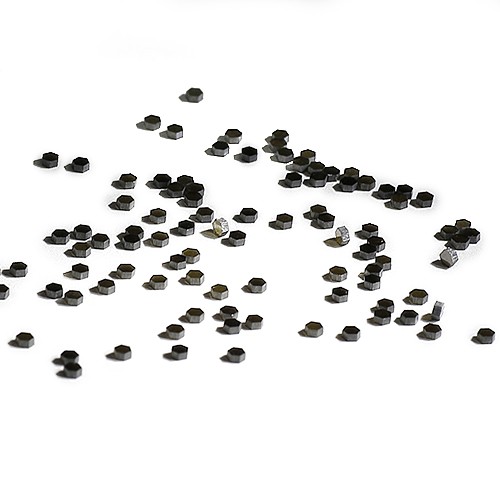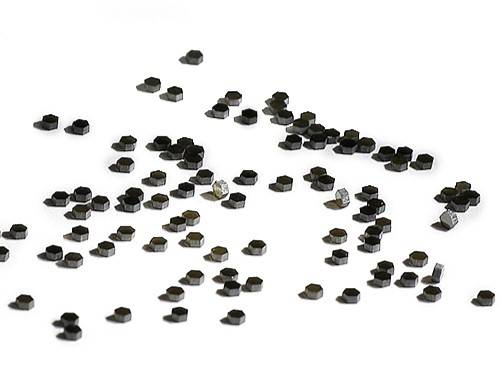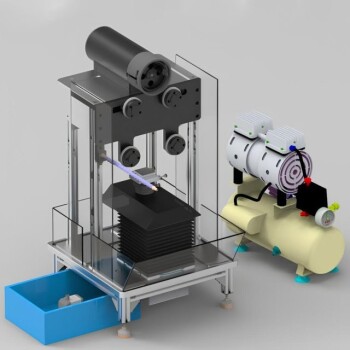
CVD materials
CVD Diamond Wire Drawing Die Blanks for Precision Applications
Item Number : cvdm-03
Price varies based on specs and customizations
Shipping:
Contact us to get shipping details Enjoy On-time Dispatch Guarantee.
Why Choose Us
Easy ordering process, quality products, and dedicated support for your business success.
Introduction
CVD Diamond wire drawing die blanks are a type of polycrystalline diamond (PCD) material used in the production of wire drawing dies. They are made from very pure diamond powder, which is deposited onto a substrate using chemical vapor deposition (CVD). This process results in a material with a high degree of hardness and abrasion resistance, making it ideal for use in wire drawing applications. CVD diamond wire drawing die blanks are also chemically stable and can be used in a variety of environments. They are widely used in the wire drawing of stainless steel, tungsten, molybdenum, copper, aluminum, and many other alloy materials.

Applications
Chemical vapor deposition (CVD) diamond wire drawing die blanks have a wide range of applications in various industries due to their exceptional hardness, abrasion resistance, and thermal conductivity. Here are the main application areas of CVD diamond wire drawing die blanks:
- Wire drawing of stainless steel, tungsten, molybdenum, copper, aluminum, and other alloy materials.
- Manufacturing of wire and cable products, such as electrical wires, communication cables, and automotive wires.
- Production of optical fibers and specialty fibers for telecommunications and medical applications.
- Fabrication of high-performance cutting tools and abrasives for machining hard and brittle materials.
- Diamond tools for machining and polishing of gemstones, ceramics, and glass.
Features
-
High hardness and abrasion resistance: CVD diamond wire drawing die blanks are made of very pure polycrystalline diamond, which gives them exceptional hardness and abrasion resistance. This means that they can withstand the wear and tear of wire drawing, even when working with hard and abrasive materials like stainless steel, tungsten, molybdenum, copper, aluminum, and various alloy materials.
-
Versatile performance: CVD diamond wire drawing die blanks can be used in a wide range of wire drawing applications, including the drawing of stainless steel, tungsten, molybdenum, copper, aluminum, and many other alloy materials. This makes them a versatile option for manufacturers who need to produce wire from a variety of materials.
-
Long-lasting performance: CVD diamond wire drawing die blanks have a long service life, which means that they can be used for extended periods without needing to be replaced. This can save manufacturers time and money in the long run.
-
Cost-effective: CVD diamond wire drawing die blanks are a cost-effective option for manufacturers who need high-quality wire drawing dies. They offer excellent performance at a competitive price.
Principle
CVD diamond wire drawing die blanks are made of very pure polycrystalline diamond without any other materials added, providing high hardness and abrasion resistance. They combine the advantages of polycrystalline and monocrystalline diamonds and are widely used in wire drawing of various materials, including stainless steel, tungsten, molybdenum, copper, aluminum, and alloys.
Advantages
-
High Hardness and Abrasion Resistance: With a Vickers hardness of 7000-10000 kg/mm2, CVD diamond wire drawing die blanks exhibit exceptional hardness and abrasion resistance, ensuring longer die life and reduced downtime.
-
Polycrystalline Structure: Combining the advantages of polycrystalline and monocrystalline diamond, these die blanks offer a unique combination of strength, toughness, and wear resistance, making them suitable for a wide range of wire drawing applications.
-
Wide Material Compatibility: CVD diamond wire drawing die blanks can be effectively utilized in wire drawing various materials, including stainless steel, tungsten, molybdenum, copper, aluminum, and numerous alloy materials.
-
Substitute for Natural and Polycrystalline Diamonds: These die blanks serve as an ideal replacement for natural and polycrystalline diamonds, providing a cost-effective and high-performance alternative.
-
Excellent Thermal Conductivity: With a thermal conductivity exceeding 1000 W/m·K, CVD diamond die blanks efficiently dissipate heat, preventing thermal damage and ensuring consistent wire drawing quality.
-
Chemical Stability: The die blanks exhibit remarkable chemical stability, being insoluble in both alkali and acid, making them suitable for use in harsh and corrosive environments.
Specification
| Product Number | Diameter of Inner Circle(mm) | Thickness(mm) |
|---|---|---|
| CVDD2010 | 2.0 | 1.0 |
| CVDD2512 | 2.5 | 1.2 |
| CVDD3015 | 3.0 | 1.5 |
| CVDD4020 | 4.0 | 2.0 |
| Note: The shapes mentioned above are hexangular. | ||
| Special specifications are available on request. | ||
| Parameters of properties | ||
| Vickers hardness | 7000-10000kg/mm2 | |
| Density | 3.51g/cm3 | |
| Young's modulus | 1000-1100GPa | |
| Thermal conductivity | >1000W/m.K | |
| Chemical stability | insoluble in alkali and acid | |
FAQ
What Are The Main Applications Of Diamond Materials?
What Are The Ideal Applications For CVD Diamond Tooling?
What Are The Advantages Of Using Diamond Materials In Industrial Applications?
What Are The Applications Of CVD Diamond Wire Drawing Die Blanks?
What Types Of Diamond Materials Are Available?
What Are The Advantages Of CVD Diamond Wire Drawing Die Blanks?
What Is The Principle Behind The Use Of Diamond Materials In Cutting Tools?
Why Is Synthetic Diamond Preferred Over Natural Diamond In Industrial Applications?
4.9 / 5
Outstanding performance and durability in wire drawing operations. Highly recommend!
4.7 / 5
Excellent value for money. These die blanks have significantly improved our productivity.
4.8 / 5
Exceptional quality and precision. Our wire drawing process has become much more efficient.
4.6 / 5
Fast delivery and responsive customer service. We are very satisfied with the product.
4.9 / 5
Technological advancement at its finest. These die blanks are a game-changer for our industry.
4.7 / 5
Highly durable and cost-effective. We have experienced significant cost savings.
4.8 / 5
Excellent abrasion resistance. Our wire drawing dies now last much longer.
4.6 / 5
Versatile performance. These die blanks work seamlessly with various wire materials.
4.9 / 5
Exceptional thermal conductivity. Our wire drawing process has become more efficient and stable.
4.7 / 5
Chemically stable and reliable. We have experienced minimal downtime and maintenance issues.
REQUEST A QUOTE
Our professional team will reply to you within one business day. Please feel free to contact us!
Related Products

CVD Diamond Cutting Tool Blanks for Precision Machining
CVD Diamond Cutting Tools: Superior Wear Resistance, Low Friction, High Thermal Conductivity for Non-Ferrous Materials, Ceramics, Composites Machining

CVD Diamond Dressing Tools for Precision Applications
Experience the Unbeatable Performance of CVD Diamond Dresser Blanks: High Thermal Conductivity, Exceptional Wear Resistance, and Orientation Independence.

Custom CVD Diamond Coating for Lab Applications
CVD Diamond Coating: Superior Thermal Conductivity, Crystal Quality, and Adhesion for Cutting Tools, Friction, and Acoustic Applications

CVD Diamond for Thermal Management Applications
CVD diamond for thermal management: High-quality diamond with thermal conductivity up to 2000 W/mK, ideal for heat spreaders, laser diodes, and GaN on Diamond (GOD) applications.

High Precision Diamond Wire Cutting Machine Laboratory Saw Precision Wire EDM Cutting Machine
The high precision diamond wire cutting machine is a versatile and precise cutting tool designed specifically for material researchers. It utilizes a continuous diamond wire cutting mechanism, enabling precise cutting of brittle materials such as ceramics, crystals, glass, metals, rocks, and various other materials.

Precision Wire Saw Laboratory Cutting Machine with 800mm x 800mm Workbench for Diamond Single Wire Circular Small Cutting
Diamond wire cutting machines are mainly used for precision cutting of ceramics, crystals, glass, metals, rocks, thermoelectric materials, infrared optical materials, composite materials, biomedical materials and other material analysis samples. Especially suitable for precision cutting of ultra-thin plates with thickness up to 0.2mm.

CVD Diamond Optical Windows for Lab Applications
Diamond optical windows: exceptional broad band infrared transparency, excellent thermal conductivity & low scattering in infrared, for high-power IR laser & microwave windows applications.

Ultra-Vacuum Electrode Feedthrough Connector Flange Power Electrode Lead for High-Precision Applications
Discover the Ultra-Vacuum Electrode Feedthrough Connector Flange, perfect for high-precision applications. Ensure reliable connections in ultra-vacuum environments with advanced sealing and conductive technology.
Related Articles

How CVD Coating Can Help You Achieve High Purity and Density
The CVD process offers several advantages over other coating techniques, such as high purity, uniformity, and the ability to deposit coatings with high-density.

Diamond Growing Machines For Modern Machining and Need for New Cutting Tools
Diamonds have become popular due to their exceptional hardness, superior thermal conductivity, and chemical stability.

Advantages of Using CVD Tube Furnace for Coating
CVD coatings have several advantages over other coating methods, such as high purity, density, and uniformity, making them ideal for many applications in various industries.

Key Materials for Successful CVD Processes
The success of CVD processes is dependent on the availability and quality of precursors used during the process.

Comparing CVD Synthetic Diamonds and HPHT Cultivated Diamonds: What are the Differences?
Both CVD and HPHT diamonds are considered to be real diamonds, as they are made up of pure carbon and have the same physical and chemical properties as natural diamonds.

How to Check if Your Diamond is CVD-Produced
When it comes to buying a diamond, it's important to understand the difference between a naturally occurring diamond and one produced using CVD technology.

The Pros and Cons of Different Lab Diamond Machine Methods
Lab-grown diamonds, also known as synthetic diamonds, are man-made diamonds produced in a laboratory setting.

A Guide to Choosing the Right Temperature for Warm Isostatic Press
Warm Isostatic Pressing (WIP) is a process used to eliminate porosity and improve the mechanical properties of materials. In this process, the material is subjected to high pressure and temperature in an inert gas environment.

Advantages and Disadvantages of Chemical Vapor Deposition (CVD)
Chemical vapor deposition (CVD) is a versatile thin-film deposition technique widely used in various industries. Explore its advantages, disadvantages, and potential new applications.

Market Prospects and Applications of CVD Diamonds
Explores the unique properties of CVD diamonds, their preparation methods, and diverse applications in various fields.

CVD Diamond: Superior Material for Optical Windows
Explores the exceptional properties and applications of CVD diamond in optical windows.

MPCVD Cultured Diamond Revolutionizes the Industry
Explores the impact of MPCVD cultured diamonds on various industries and strategies for cost reduction and efficiency improvement.